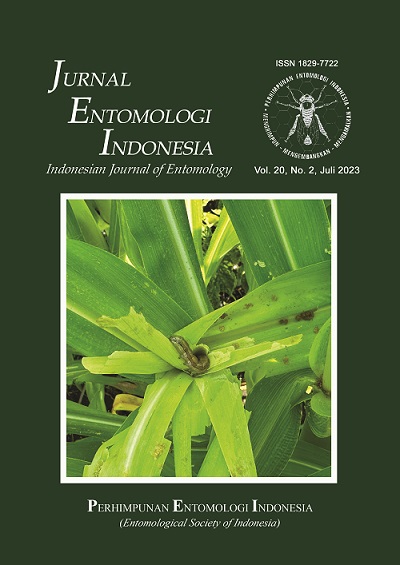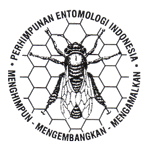Analisis filogenetik Hyposidra talaca nucleopolyhedrovirus (HytaNPV) yang diisolasi dari perkebunan teh Gunung Mas, Bogor, Jawa Barat dan virulensinya terhadap Hyposidra talaca Walker
DOI:
https://doi.org/10.5994/jei.20.2.151Keywords:
entomopathogen, genetic variability, molecular characteristic, polymerase chain reaction, teaAbstract
Hyposidra talaca (Walker) is an important pest of tea plant. H. talaca can cause losses of between 40–100% in the dry season if proper control is not carried out. H. talaca has natural enemies such as predators, parasitoids, and pathogens. One of the entomopathogens is NPV. This study aims to obtain molecular characteristics through DNA polymerase sequences and determine the virulence level of NPV isolates from H. talaca. The same species from different locations can have genetic variability. Therefore, molecular characterization by polymerase chain reaction (PCR) on DNA polymerase sequences is one way to study the genetics of HytaNPV. NPV was isolated from infected H. talaca larvae collected from the field. The DNA isolates were used as templates for PCR for DNA polymerase gene amplification with an amplicon target of ±1,000 bp. A sequencing process followed the PCR provides nucleotide sequence. HytaNPV DNA polymerase sequencing results were aligned with GenBank's BLAST data to provide information on the relationship of HytaNPV to NPVs isolated from other regions. Based on molecular character analysis using DNA polymerase gene sequence, HytaNPV Bogor has a homology level of 93.9% with HytaNPV isolated from India. HytaNPV Bogor has a genetic relationship with the NPV that infects Buzura suppressaria from China and Australia. HytaNPV Bogor is similar to the NPV that infects H. talaca from India. The bioassay of HytaNPV isolate against H. talaca showed the highest LT50 value of 1.92 days was found in concentration of 1.58 x 107 POBs/ml in second instar larvae.
Downloads
References
Abbott WS. 1925. A method of computing the effectiveness of an insecticide. Journal of Economic Entomology. 18:265–267. DOI: https://doi.org/10.1093/jee/18.2.265a
Battistuzzi F, Kumar S. 2020. Molecular phylogeny reconstruction. eLS. 1:558–564. DOI: https://doi.org/10.1002/9780470015902.a0029212.
Cheng XW. 1998. Characterization of Nuclearpolyhedrosis viruses from Thysanplusia orichalcea (L) (Lepidoptera: Noctuidae) from Indonesia. Disertasi. Amerika Serikat: Clemson University.
Doyle JJ, Doyle JL. 1990. A rapid total DNA preparation procedure for fresh plant tissue. Focus. 12:13–15.
Federici BA. 1997. Baculovirus pathogenesis. In: Miller LK (Ed.) The Baculoviruses. hlm. 33–56. New York: Springer Science + Business Media, LLC. DOI: https://doi.org/10.1007/978-1-4899-1834-5_3.
Franco-Duarte R, Černáková L, Kadam S, S Kaushik K, Salehi B, Bevilacqua A, Corbo MR, Antolak H, Dybka-Stępień K, Leszczewicz M, Relison Tintino S, Alexandrino de Souza VC, Sharifi-Rad J, Melo Coutinho HD, Martins N, Rodrigues CF. 2019. Advances in chemical and biological methods to identify microorganisms—from past to present. Microorganisms. 7:130. DOI: https://doi.org/10.3390/microorganisms7050130.
Gerdol M, Zhao H, Wang Y, Xing F, Liu X, Yuan C, Qi G, Guo J, Dong Y. 2018. The genetic diversity and geographic differentiation of the wild soybean in northeast China based on nuclear microsatellite variation. International Journal of Genomics. 2018:8561458. DOI: https://doi.org/10.1155/2018/8561458.
Gorbalenya AE, Lauber C. 2017. Phylogeny of viruses. In: Reference Module in Biomedical Sciences. Elsevier. DOI: https://doi.org/10.1016/B978-0-12-801238-3.95723-4.
Goto C, Minobe Y, Izuka T. 1992. Restriction endonuclease analysis and mapping of the genomes of granulosis viruses isolated from Xestia c-nigrum and five other noctuid species. Journal of General Virology. 73:149l–1497. DOI: https://doi.org/10.1099/0022-1317-73-6-1491.
Jose J, Jalali SK, Shivalingaswamy TM, Kumar NKK, Bhatnagar R, Bandyopadhyay. 2013. Molecular characterization of nucleopolyhedrovirus of three Lepidopteran pest using late expression factor-8 gene. Indian Journal of Virology. 24:59–65. DOI: https://doi.org/10.1007/s13337-013-0126-3.
Kusumah YM, Halala YT. 2014. Biologi Hyposidra talaca Wlk. pada beberapa jenis tanaman selain tanaman teh di sekitar perkebunan teh Gunung Mas PTPN VIII Bogor. In: Nawangsih et al. (Eds.), Prosiding Seminar Nasional Perlindungan Tanaman II: Strategi Perlindungan Tanaman dalam Memperkuat Sistem Pertanian Nasional Menghadapi ASEAN Free Trade Area (AFTA) dan ASEAN Economic Community (AEC) 2015, (Bogor, 13 November 2014). pp. 45–58. Bogor: PKPHT.
Laoh JH, Puspita F. 2003. Kerentanan larva Spodoptera litura F. terhadap virus nuklear polyhedrosis. Jurnal Natur Indonesia. 5:145–151.
Mukhopadhyay A, Khewa S, De D. 2011. Characteristics and virulence of nucleo-polyhedrovirus isolated from Hyposidra talaca (Lepidoptera: Geometridae), a pest of tea in Darjeeling Terai, India. International Journal of Tropical Insect Science. 31:13–9. DOI: https://doi.org/10.1017/S1742758411000026.
Nagy LG, Merényi Z, Hegedüs B, Bálint B. 2020. Novel phylogenetic methods are needed for understanding gene function in the era of mega-scale genome sequencing. Nucleic Acids Research. 48:2209–2219. DOI: https://doi.org/10.1093/nar/gkz1241.
Newell PD, Fricker AD, Roco CA, Chandrangsu P, Merkel SM. 2013. A small-group activity introducing the use and interpretation of BLAST+. Journal of Microbiology & Biology Education. 14:238–243. DOI: https://doi.org/10.1128/jmbe.v14i2.637.
Pradana R. 2013. Pengelolaan Kebun dan Upaya Pengendalian Hama Ulat Jengkal (Hyposidra talaca) dengan Aplikasi Hyposidra talaca Nucleopolyhedrovirus pada Tanaman Teh di PT Perkebunan Nusantara VIII Gunung Mas Bogor, Jawa Barat. Skripsi. Bogor: Institut Pertanian Bogor.
Shapiro, M, Fuxa JR, Braymer HD, Pashley DP. 1991. DNA restriction polymorphism in wild isolates of Spodoptera frugiperda nuclear polyhedrosis virus. Journal of Invertebrate Pathology. 58:96–105. DOI: https://doi.org/10.1016/0022-2011(91)90167-O.
Sinulingga P. 2017. Analisis Filogenetik Hyposidra Talaca Nucleopolyhedrovirus dengan Sekuens DNA Polimerase. Skripsi. Bogor: Institut Pertanian Bogor.
Sudjarwo. 1987. Sejarah Hidup Hyposidra talaca Wlk. (Lepidoptera: Geometridae) di Kebun Coklat. Skripsi. Bogor: Institut Pertanian Bogor
Tanada Y, Kaya HK. 1993. Insect Pathology. California: Academic Press.
Vega FE, Kaya HK. 2012. Insect Pathology 2nd ed. California: Academic Press.
Williams T, Melo-Molina GdC, Jiménez-Fernández JA, Weissenberger H, Gómez-Díaz JS, Navarro-de-la-Fuente L, Richards AR. 2023. Presence of Spodoptera frugiperda multiple Nucleopolyhedrovirus (SfMNPV) occlusion bodies in maize field soils of mesoamerica. Insects. 14:80. DOI: https://doi.org/10.3390/insects14010080.
Yang SF, Lu CW, Yao CT, Hung CM. 2019. To trim or not to trim: Effects of read trimming on the de novo genome assembly of a widespread East Asian Passerine, the Rufous-capped Babbler (Cyanoderma ruficeps Blyth). Genes. 10:737. DOI: https://doi.org/10.3390/genes10100737.
Yasin M, Qazi MS, Wakil W, Qayyum MA. 2020. Evaluation of nuclear polyhedrosis virus (NPV) and emamectin benzoate against Spodoptera litura (F.) (Lepidoptera: Noctuidae). Egyptian Journal of Biological Pest Control. 30:1–6. DOI: https://doi.org/10.1186/s41938-020-00271-8.
Yi-Peng Xu, Ruo-Lin Cheng, Yu Xi, Chuan-Xi Zhang. 2013. Genomic diversity of Bombyx mori nucleopolyhedrovirus strains. Genomics. 102:63–71. DOI: https://doi.org/10.1016/j.ygeno.2013.04.015.
Downloads
Published
How to Cite
Issue
Section
License
Copyright (c) 2023 R. Yayi Munara Kusumah, Fitrianingrum Kurniawati, Eka Dana Kristanto, Franciskus Parasian, Michael Christian

This work is licensed under a Creative Commons Attribution 4.0 International License.
Authors who publish with this journal agree to the following terms:
- Authors retain copyright and grant the journal right of first publication with the work simultaneously licensed under a Creative Commons Attribution 4.0 International License that allows others to share the work with an acknowledgement of the work's authorship and initial publication in this journal.
- Authors are able to enter into separate, additional contractual arrangements for the non-exclusive distribution of the journal's published version of the work (e.g., post it to an institutional repository or publish it in a book), with an acknowledgement of its initial publication in this journal.
- Authors are permitted and encouraged to post their work online (e.g., in institutional repositories or on their website) prior to and during the submission process, as it can lead to productive exchanges, as well as earlier and greater citation of published work (See The Effect of Open Access).








